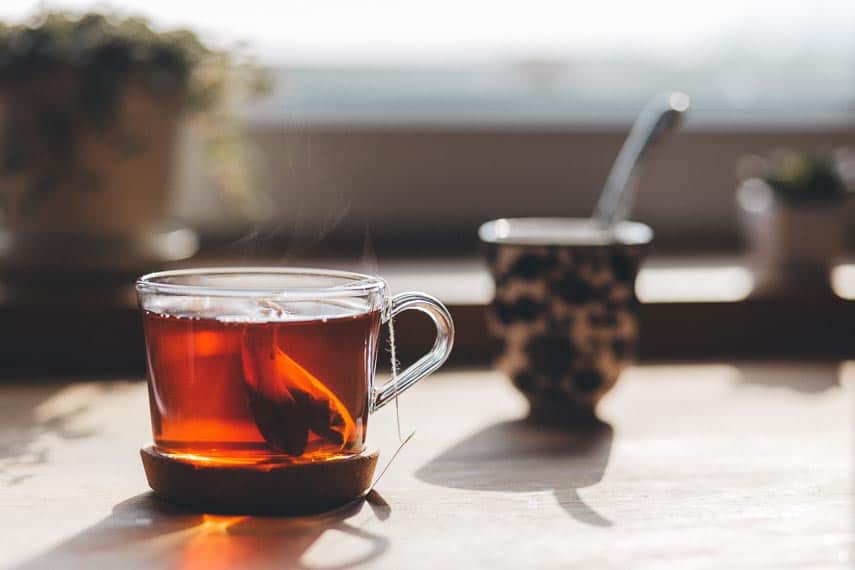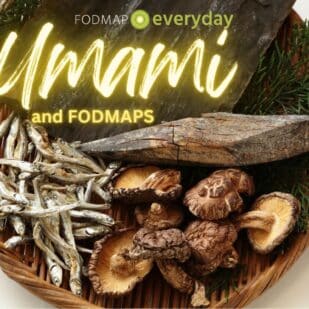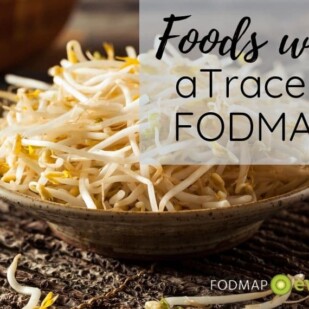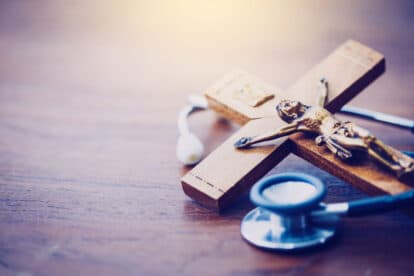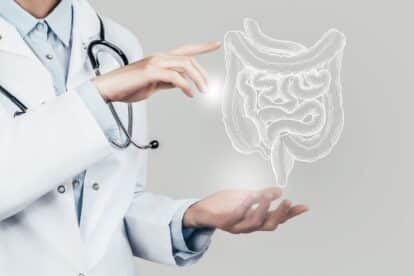You can drink tea while following the low FODMAP diet. This article is all about various kinds of Tea & FODMAPs and we will look at what you can enjoy and in what quantities.
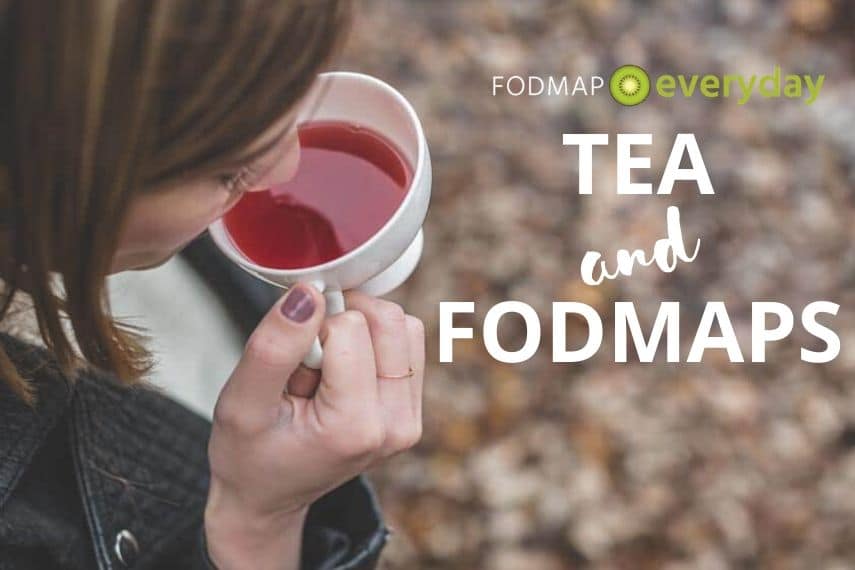
What Is Tea?
First things first. All tea comes from the Camellia sinensis plant, which is an evergreen bush that flourishes in tropical and subtropical environments. This includes black tea, oolong, green and white tea, which are the most common teas that you will come across.
There is also yellow tea and others, such as Pu-erh, which is a fermented tea. What they all have in common is that they are made from the leaves of the Camellia sinensis plant. What differentiates them is how the leaves are processed and to what degree the leaves are oxidized. There is also kukicha, which is made from the twigs of the plant.
As an interesting fact, tea is the most widely consumed beverage in the world next to water.
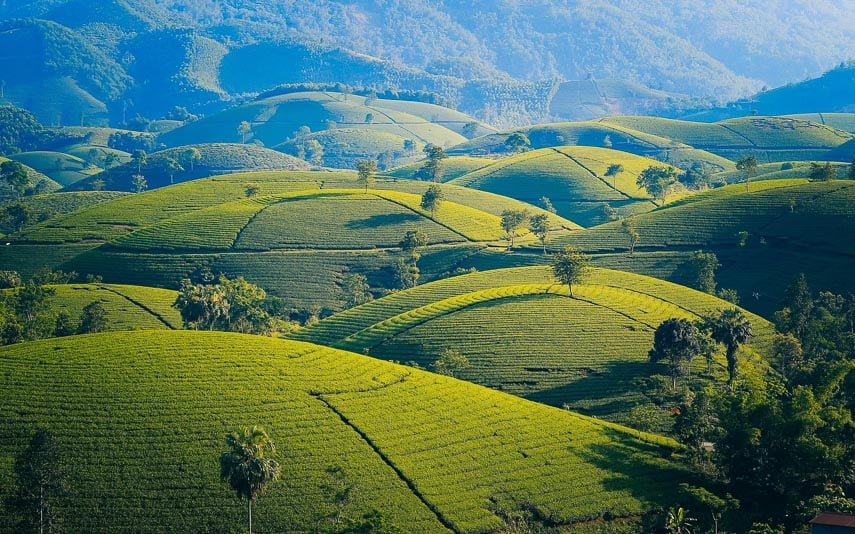
Caffeine & Teas
The caffeine content in your tea beverage varies depending on the tea that is brewed and how the drink is prepared (weakly, strongly, etc.)
Caffeine is found in over 60 plant species but is most often ingested via coffee, chocolate and tea. It can be a gut irritant, so always imbibe to your tolerances. Please note that these are averages:
- An 8-ounce (240 ml) cup of brewed coffee contains an average of 95 mg of caffeine.
- A 1-ounce (30 ml) shot of espresso contains an average of 64 mg of caffeine.
- An 8-ounce (240 ml) cup of black tea contains an average of 47 mg of caffeine
- An 8-ounce (240 ml) cup of oolong tea contains an average of 37 mg of caffeine
- An 8-ounce (240 ml) cup of brewed green tea contains an average of 11 – 25 mg of caffeine
- An 8-ounce (240 ml) cup of matcha contains an average of 19 – 45 mg of caffeine
- An 8-ounce (240 ml) cup of white tea contains an average of 28 mg of caffeine
Herbal “Teas”
Technically, herbal infusions and tisanes such as chamomile and peppermint are not teas as they do not come from the Camellia sinensis plant. Peppermint tea, as an example, is made from the leaves of the peppermint plant. Of course, the term “tea” is used very broadly by the average person looking for a bracing or refreshing hot or cold beverage.
Peppermint tea, by the way, is very soothing for many people with IBS and might be worth trying.
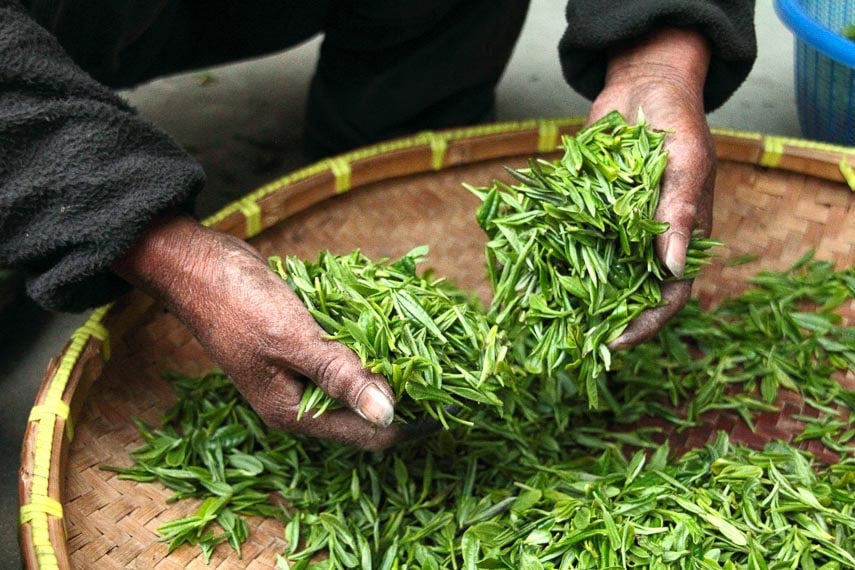
FODMAP Levels In Tea & Herbal Infusions
The graphic below shows you FODMAP levels in tea proper, meaning black, oolong, green and white, where lab testing has been done and reported.
Low FODMAP Amounts Tea
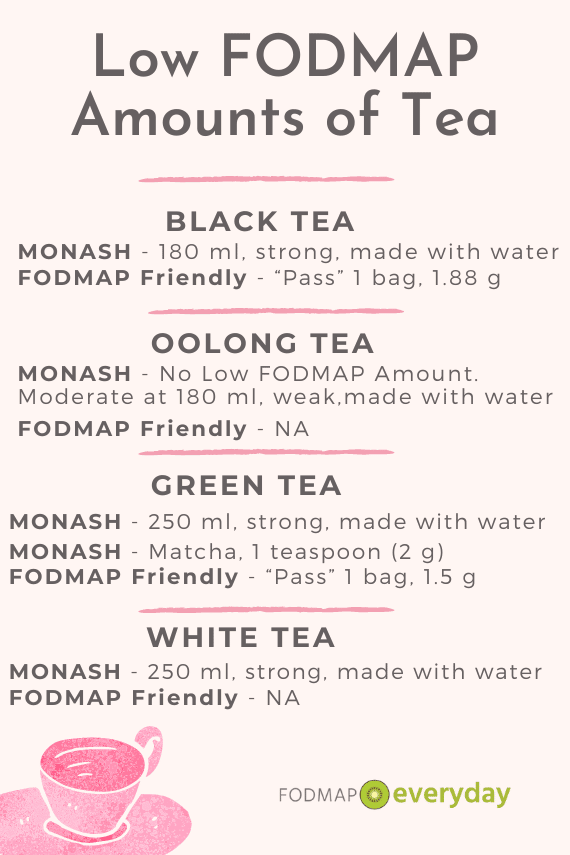
A note on Oolong: We do not know what kind of oolong teas were lab tested. If you tolerate black tea and green tea well, it would be worth Challenging yourself with oolong tea, when you are stable, to determine your digestive reactions – if you are interested in having oolong tea.
Although Monash has lab tested “chai”, they have not detailed what it was that they tested. Was it based on black tea? What spices were present and in what concentrations? Because of this, the app listing is fairly unhelpful and therefore I have not included “chai” in our charts.
If you are a spiced tea devotee, please check out our recipe for Low FODMAP Masala Chai.
Same goes for “herbal” tea. Monash has an “herbal” tea listed in the app, but without knowing what herb or herbs were tested, this is a useless entry.
A note on Matcha. We get many questions about matcha, which is simply ground green tea. It is true that green tea has been lab tested and we know low FODMAP amounts, but that is for an infusion of leaves. When you drink matcha, you are ingesting the entire leaf. The FODMAP content is bound to be different, and higher.
As of early 2023 Monash University lab tested matcha. Matcha has a low FODMAP serving size of 1 teaspoon (2 g). It becomes Moderate for FODMAPs at 4 ½ teaspoons (9g ) and High FODMAP at 6 teaspoons (12 g).
Below is a chart of herbal and other “teas” that have been lab tested for FODMAPs.
Low FODMAP Amounts of Herbal & Other Infusions
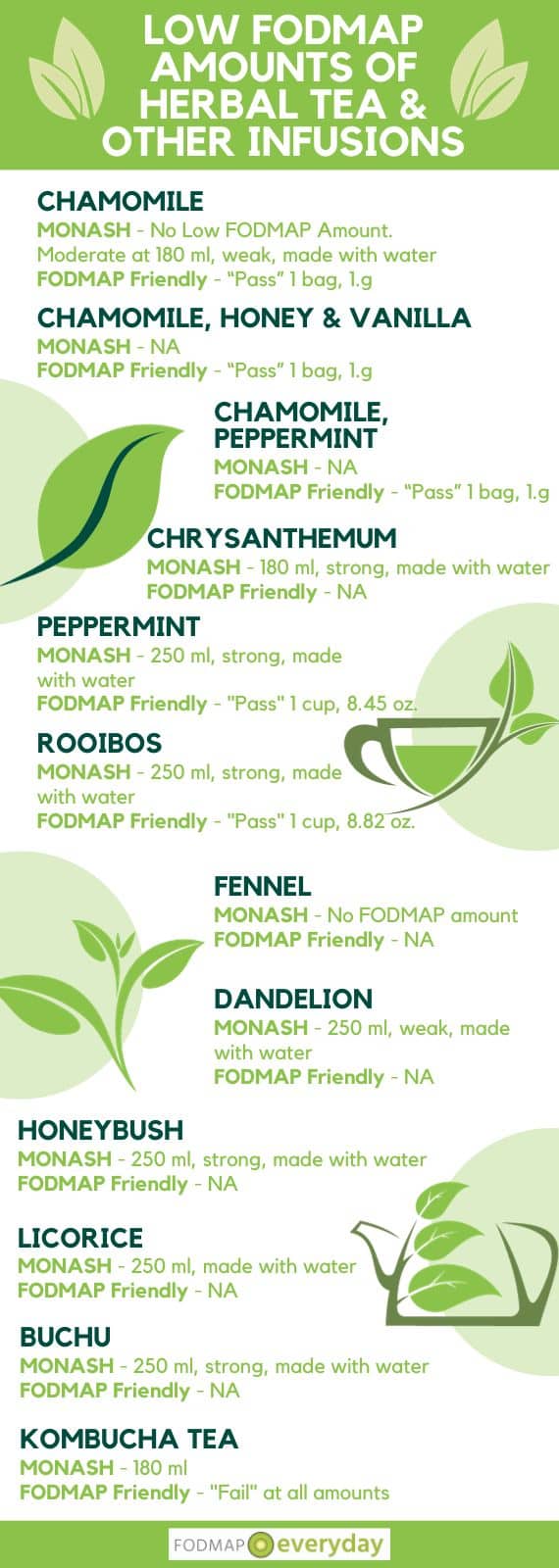
Please note that while Monash recommends the 250 ml serving size of licorice tea as one low FODMAP serving, they also report that no FODMAPs have been detected in this tea.
How Tea Is Made
As mentioned before, all tea comes from the Camellia sinensis plant and whether we end up with black or oolong, green or white depends on how the plant is handled after harvest.
During harvest the very top leaves of each branch are plucked. This usually means leaves are removed from just the top one or two inches (2.5 cm to 5 cm) of the tea plant and each plucking is known as a “flush”. So, if you see the term “first flush” or “second flush” in association with a tea, it is referencing when the tea was harvested. The tender top leaves continue to grow and are produced about every 7 to 15 days during harvest season, allowing subsequent “flushes”.
The plucking of the leaves can be done by hand or can be mechanized somewhat. Finer teas will be plucked by hand. Once the tea leaves are plucked, they are taken from the fields to a location and facility where they will be inspected and sorted, and processing begins.
From here on in, depending on how they are treated, the leaves become black, oolong, green or white tea.

Black Tea
When you order a cup of tea and if you have not specified anything other than you’d like a cup of tea, chances are you will be offered black tea. In the U.S. many of us grew up with Lipton, Twining’s English Breakfast and Red Rose tea bags and these are all black tea. If you order “iced tea” in an American restaurant, it will be made from black tea.
In the U.K you might find PG Tips, Taylor’s of Harrogate Yorkshire Tea, Barry’s Tea or Lyons. All of these (and the ones mentioned from the U.S., too) are inexpensive supermarket quality teas, meaning not top notch, but they are ubiquitous and very popular. If you like it, it is “good tea”!
How Black Tea Is Made
Withering
Fresh tea leaves intended to become black tea will be withered, which is a technical tea term. It simply refers to the fact that the moment the leaves are plucked, they begin to lose moisture. This happens on its own, but tea makers will also take control of the process to produce the amount of withering that they want. This is done by using heat and humidity (fans and temperature control) and can take hours or a full day.
During withering amino acids and simple sugars form. Complex compounds break down into simpler volatile compounds and the process highly affects a finished tea’s aroma. Enzymatic activity increases as does the concentration of caffeine. The cell walls of the leaf break down and slowly begin oxidation. All of this makes the leaves more pliable and ready for the next step of rolling.
Rolling
The main purpose of rolling tea leaves is to damage the cell walls, which exposes enzymes to the air and subsequently speeds up the process of oxidation. Black tea makers want oxidation to occur because aromatic compounds increase, lending black tea the lovely aromas and flavors that we look for.
Black tea rolling takes one of two approaches: Orthodox or CTC, which stands for Cut, Tear and Curl, or Crush, Tear and Curl.
For an orthodox approach the tea leaves are twisted and pressed by hand in order to extract moisture that is held within the cell walls. The goal is to distribute the moisture evenly on the outside of the leaves, which encourages and hastens the oxidation.
For CTC tea, the withered leaves are shredded mechanically into very fine, even particles. This method is commonly used for producing lower grade tea dust and fannings, which is what you find in the common, supermarket tea bags.
Oxidation
The next step is oxidation where the leaves are held under controlled conditions of temperature, oxygen level, and humidity. The leaves begin turning brown and dark at this point and much of their color, flavor and aromatic development occurs.
Drying
Once oxidized, the leaves are thoroughly dried, after which they can be packaged for sale, either as loose tea, packaged as tea bags or sold in bulk for manufacturers of prepared tea, such as RTD tea – the industry term for “ready-to-drink”. Bottled iced tea is an example of RTD.
Many popular flavored teas, such as Earl Grey, are flavored black teas.
Oolong Tea
Oolong teas are partially oxidized teas and are often considered to be between black and green teas in their aroma and flavors.
Similar to black teas, the leaves are withered but then the oxidation process is less than that for black teas and also depends on the type of oolong. Green oolongs are oxidized the least, about 20% of the way, and darker oolongs such as classic Formosa oolongs, are oxidized about 60% of the way.
After the desired oxidation level is reached the leaves are pan-fired at high temperatures, which prevents further oxidation. BTW, due to the high firing temperatures, oolong teas contain less moisture and have a longer shelf life than green teas.
Green Tea
Green teas are unoxidized and sometimes also referred to as non-fermented or unfermented teas. By preventing oxidization of the leaves, the natural green color and grassy, fresh flavors and aromas are highlighted. The traditional method of processing green teas involves withering – though not always – and then heating, rolling and drying.
After picking, and naturally drying in the sun, or warm air for an hour or two, the leaves are heated to prevent oxidation and preserve freshness. Then the leaves are rolled into various shapes and dried. Chinese green teas are often pan fired in large woks and then rolled by hand into various styles – twisted, flat, curly or even into small balls. Green teas from China often result in a paler color brew.
In Japan, the plucked leaves are quickly steamed on a bamboo tray over water or sometimes in a machine. Then the leaves are rolled by hand or machine before being dried. Japanese green teas are often very vivid green in color, partially due to the steaming process, both as a dry leaf and after brewing.
Green teas contain a higher concentration of chlorophyll, polyphenols and antioxidants than some other types of tea, such as black.
White Tea
White tea is produced mainly in the Fujian province of China. It gets its name from the tender leaf buds that are covered with whitish hairs. The tea leaves are plucked before they open in early spring, then withered and dried slowly at low temperatures.
The leaf buds are not rolled and allowed to oxidize only slightly. The result is a very mild tea, that some find naturally sweet.
Buying Tea
As an admitted tea connoisseur, I brew loose tea every day. This allows me to control the quality of the leaves I purchase and also finely tune the brewing process. I occasionally buy tea bags for when I am travelling.
My favorite vendors are Mariage Freres and Upton Tea, both of whom offer hundreds of teas from which to choose. If you ever get a chance to visit the Mariage Freres location in the Marais in Paris, I encourage you to do so. Visit the Tea Museum and sit in the café and have expertly prepared tea.
My tea “wall” was patterned after the way they display tea at Mariage Freres, and it brings me joy every single day when I choose my brew of the day.
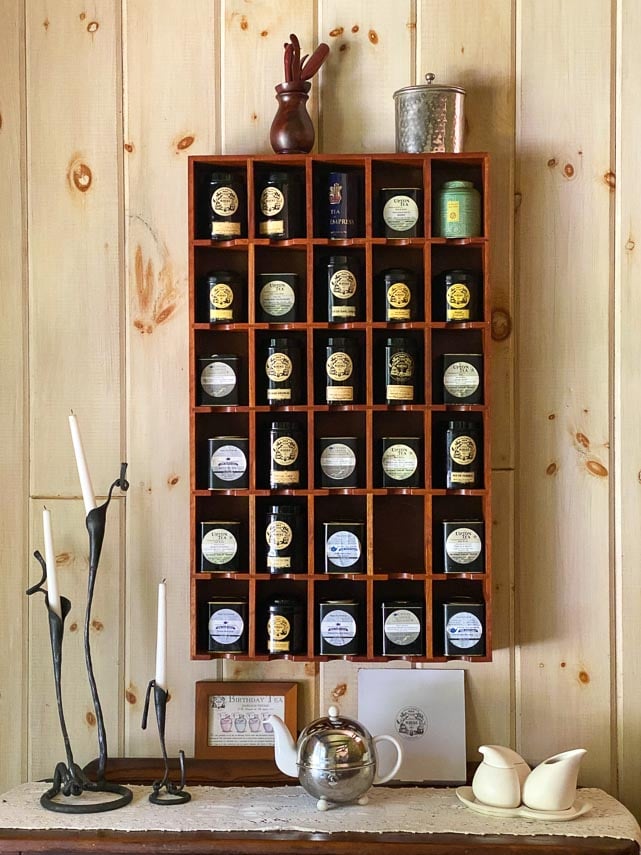
There are numerous vendors online that carry very high-quality tea. It is of course up to you whether you want to buy and brew loose, or whether tea bags and their convenience is a more attractive option.
If you are a black tea connoisseur, some of my favorites are Mariage Freres Yunnan Imperial and this Keemun Mao Feng from Upton Tea.
Brewing Tea
Ah, brewing tea. I could write a very long treatise just on this. For our purposes here I am just going to suggest that you follow your product’s recommendations. For instance, I have loose black teas that I brew for 3 minutes, others for 5 and one for 8 minutes! I have green teas that I brew for 30 seconds, and others for several minutes. It all depends on the tea. Water temperature varies as well, depending.
And if you want to buy, for yourself for as a gift, the most amazing tea pot, look no further than this art deco wonder from Mariage Freres. It consists of a ceramic pot and an elegant metal tea cozy that is lined in felt. It is beautiful as well as functional. I brew my tea in one every morning and as part of my daily ritual, it sets me up for the hours ahead.Here are some tea brewing general pointers:
- Begin with good water. This can be tap water for some, filtered or bottled for others. If you like drinking it plain, you can use it to brew tea.
- Make sure you understand the correct temperature of water for your tea, which is generally higher for black teas, lower for green, etc.
- Measuring loose tea is an art. You could use a digital scale, but if you have a tea scoop and brew loose every day, as I do, you become used to what a mound of fluffy tea leaves should look like per 6-ounce (180 ml) cup of water versus what a portion of CTC dry tea will be.
- Brew time: Again, this will greatly depend on the type of tea you are brewing. Follow product directions and if you brew the same tea enough, you will learn what you like, and adjust your brew times accordingly.
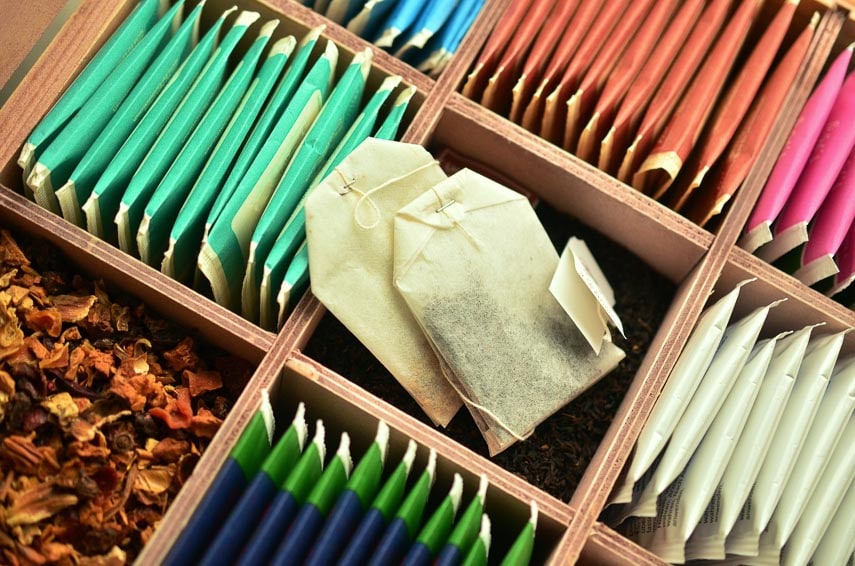
Low FODMAP Tea Recipes
- Peach Iced Tea
- Green Tea With Passionfruit
- White Tea With Mango
- Black Iced Tea with Lychee
- Low FODMAP Masala Chai
- Strawberry Arnold Palmer
- Arnold Palmer Popsicles
The Takeaway
Many kinds of teas and herbal infusions can be enjoyed while following the low FODMAP diet. Just as we strive to inspire you to eat broadly without triggering IBS symptoms, we hope that this article has encouraged you to think about beverages as well. Stay hydrated deliciously!

